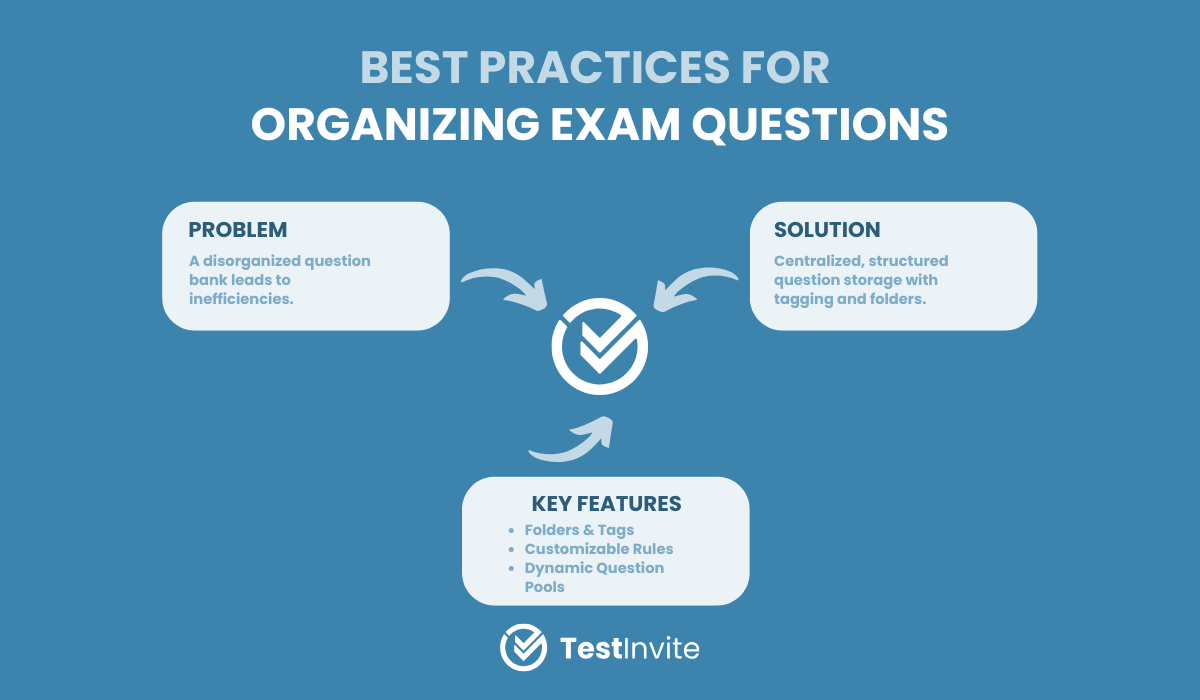All Resources

However, managing hundreds—or even thousands—of questions requires more than simple storage. Proper tagging and categorization are essential for ensuring that finding the right questions doesn’t become a daunting challenge.
In this article, we’ll explore how to structure an online question bank to enable efficient management of exam questions and facilitate quick exam creation, leveraging the power of a well-organized question repository.

A question bank serves as a centralized repository for storing all test questions, making it easy to search, filter, and use them whenever needed. Questions can be directly included in a test or grouped into a question pool, allowing the assessment engine to dynamically randomize questions based on predefined selection criteria.
For example, consider a training program where questions are tailored to different learning modules. By using a question pool, you can ensure unique tests for each participant while maintaining fairness and consistency.
This is why effectively classifying questions is crucial—when done correctly, it can save significant time, reduce errors, and streamline the entire test creation process.
To maintain clarity and accessibility, questions in a well-structured question bank should be organized into distinct folders. This prevents different types of questions from being mixed together, ensuring easy retrieval.
Within each folder, questions should be tagged with multiple attributes, such as topics, difficulty levels, or learning objectives. These tags allow the system to filter and present questions based on selected criteria, enabling efficient organization and retrieval.
For example, a folder for "Math Questions" might include tags like "Algebra," "Geometry," or "Advanced Difficulty." Such categorization ensures that you can quickly locate and compile relevant questions, no matter the test requirements.
Sometimes, maintaining structure and consistency requires enforcing specific rules for question bank users. For instance, you might want every question in a folder to have certain tags, such as "Topic" and "Difficulty Level," with predefined value options.
At the same time, some folders may not need such restrictions, offering more flexibility. The ideal solution is to allow organizations to customize usage restrictions on a per-folder basis, tailoring the level of control to their specific needs.
This flexibility ensures that your question bank remains both structured and adaptable, meeting the unique demands of your organization.
Each organization in TestInvite has its own dedicated question bank for storing exam questions. Questions can be organized under a single folder and assigned multiple tags, with each tag consisting of a name-value pair.
By default, the system allows complete freedom for users to create tag names and assign values. However, over time, organizations can implement custom schema rules for specific folders. These rules can require certain tags to be assigned to questions and define permissible values for those tags, ensuring consistency and accuracy.
TestInvite’s question bank is designed for flexibility, efficiency, and organization. With features like customizable tagging, folder-based schema rules, and dynamic question pools, it empowers organizations to streamline their question management and test creation processes.
A well-organized question bank is the backbone of efficient assessment management. By leveraging folders, tags, and customizable rules, you can create a system that saves time, reduces errors, and supports consistent test creation.
If your organization manages multiple exam questions and needs a solution to centralize and optimize its processes, TestInvite is the ultimate platform. Its flexible question bank is built to adapt to your needs, whether you’re running a corporate training program or managing academic assessments.
Ready to transform how you manage exam questions? Explore TestInvite today and experience the power of a streamlined question bank tailored to your organization’s needs.